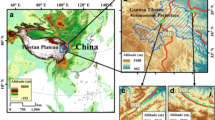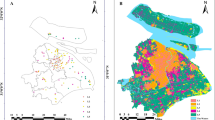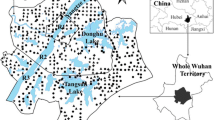Abstract
A detailed investigation was conducted to study the effect of highway on the accumulation of heavy metals in soils of turfy swamps. The concentrations of Cr, Zn, Cu, and Cd showed a decreasing trend with increasing distance from the road, while such trend was not identified in Pb, Ni, Co, and As. The results of factor analysis and cluster analysis indicated that Cr, Zn, Cu, and Cd were in a closer relationship than other metals and might be derived from common sources. The soil samples from JY and LQ sites with the highest traffic volume had the highest heavy metal concentrations of the three highways, while the concentrations of Cr and Cu were significantly positively correlated with traffic volumes (p < 0.05). Contamination levels of traffic-related metals were evaluated using the geo-accumulation index (I geo) and enrichment factor (EF) in turfy soil. The I geo index for Cr, Zn, Cu, and Cd varied from unpolluted to the heavily polluted, and the enrichment factor (EF) ranged from 0.44 (no enrichment) to 8.38 (significant enrichment) at JY and LQ site. For HSD site, the I geo index and EFs of Cr, Zn, and Cd in turfy soils were lower than that in JY and LQ, ranged from uncontaminated to moderate contamination and no enrichment to moderate enrichment, respectively. The I geo index and EFs of Cd were higher than 1 among all three sites. Therefore, Cd should be paid more attention to avoid potential risk to the flora and fauna in turfy swamps. The affected area of traffic-related metals was <30 m from the highway; this may be due to the abundant precipitation and long cold winter in Changbai Mountain area. The heavy metals could move with rainfall runoff and snowmelt in both particulate and dissolved forms.






Similar content being viewed by others
References
Adachi, K. & Tainosho, Y., 2004. Characterization of heavy metal particles embedded in tire dust., 30, pp.1009–1017.
Bassi, N., Kumar, M. D., & Sharma, A. (2014). Status of wetlands in India: a review of extent, ecosystem benefits, threats and management strategies. Journal of Hydrology: Regional Studies, 2(November), 1–19.
Bilos, C., et al. (2001). Sources, distribution and variability of airborne trace metals in la Plata City area, Argentina. Environment Pollution, 111, 149–158.
Blake, L., & Goulding, K. W. T. (2002). Effects of atmospheric deposition, soil pH and acidification on heavy metal contents in soils and vegetation of semi-natural ecosystems at Rothamsted Experimental Station, UK. Plant and Soil, 240(March), 235–251.
Blok, J. T. (2005). Environmental exposure of road borders to zinc. Science of the Total Environment, 348, 173–190.
Chen, X., et al. (2010). Heavy metal concentrations in roadside soils and correlation with urban traffic in Beijing, China. Journal of Hazardous Materials, 181(1–3), 640–646.
Chen, H., et al. (2015). Contamination features and health risk of soil heavy metals in China. Science of the Total Environment, 512–513, 143–153.
Chen, M. et al. (2001). Arsenic Background Concentrations in Florida, U.S.A. Surface SoilsDetermination and Interpretation. Environment Forensics, 2, 117–126.
CNEMC. (1990). The backgrounds of soil environment in China. Beijing: China Environmental Science Press.
Davis, A. P., Shokouhian, M., & Ni, S. (2001). Loading estimates of lead, copper, cadmium, and zinc in urban runoff from specific sources. Chemosphere, 44, 997–1009.
Duong, T. T. T., & Lee, B. (2011). Determining contamination level of heavy metals in road dust from busy traf fi c areas with different characteristics. Journal of Environmental Management, 92(3), 554–562.
Golomb, D., et al. (1997). Atmospheric deposition of toxics onto Massachusetts bay-I. Metals. Atmospheric Environment, 31, 1349–1359.
Guan, Q., et al. (2016). Distribution features and controls of heavy metals in surface sediments from the riverbed of the Ningxia-inner Mongolian reaches, Yellow River, China. Chemosphere, 144, 29–42.
Heiri, O., Lotter, A. F., & Lemcke, G. (2001). Loss on ignition as a method for estimating organic and carbonate content in sediments: reproducibility and comparability of results. Journal of Paleolimnology, 25, 101–110.
Hu, B., et al. (2013). Occurrence and distribution of heavy metals in surface sediments of the Changhua River estuary and adjacent shelf (Hainan Island). Marine Pollution Bulletin, 76(1–2), 400–405.
Jia, L., Wang, G., & Liu, J. (2006). Distribution and implications of the elements of peat profiles in the jinbei bog of the Changbai Mountains. Wetland Science, 4, 187–192.
Johansson, C., Norman, M., & Burman, L. (2009). Road traffic emission factors for heavy metals. Atmospheric Environment, 43, 4681–4688.
Khan, M. N., et al. (2011). Assessment of heavy metal toxicants in the roadside soil along the N-5, National Highway, Pakistan. Environmental Monitoring and Assessment, 182, 587–595.
Lantzy, R. J., & Mackenzie, F. T. (1979). Atmospheric trace metals: global cycles and assessment of Man’s impact. Geochimica et Cosmochimica Acta, 43, 511–525.
Lee, C. S., et al. (2006). Metal contamination in urban, suburban, and country park soils of Hong Kong: a study based on GIS and multivariate statistics. Science of the Total Environment, 356, 45–61.
Li, F., et al. (2007). Traffic-related heavy metal accumulation in soils and plants in northwest China. Soil & Sediment Contamination, 16, 473–484.
Liu, J., & Diamond, J. (2005). China’s environment in a globalizing world. Nature, 435, 1179.
Liu, H., et al. (2009). Heavy metal contamination in soil alongside mountain railway in Sichuan, China. Environmental Monitoring and Assessment, 152, 25–33.
Liu, Q., Liu, Y., & Zhang, M. (2012). Mercury and cadmium contamination in traffic soil of Beijing, China. Bulletin of Environmental Contamination and Toxicology, 88, 154–157.
Liu, M., et al. (2015). The environment quality of heavy metals in sediments from the central Bohai Sea. Marine Pollution Bulletin Journal, 100, 534–543.
Lu, Q., et al. (2016). Spatial and seasonal distribution and risk assessments for metals in a Tamarix Chinensis wetland, China. Wetlands, 36, 125–136.
Ma, J., et al. (2009). Heavy metal pollution in soils on railroad side of Zhengzhou-Putian section of Longxi-Haizhou railroad, China. Pedosphere, 19, 121–128.
Mays, P. A., & Edwards, G. S. (2001). Erratum to “comparison of heavy metal accumulation in a natural wetland and constructed wetlands receiving acid mine drainage.”. Ecological Engineering, 18, 251–252.
Micó, C., et al. (2006). Assessing heavy metal sources in agricultural soils of an European Mediterranean area by multivariate analysis. Chemosphere, 65, 863–872.
Morselli, L., et al. (2003). Soluble and insoluble fractions of heavy metals in wet and dry atmospheric depositions in bologna, Italy. Environmental Pollution, 124, 457–469.
Motto, H. L., et al. (1970). Lead in soils and plants: its relationship to traffic volume and proximity to highways. Environmental Science & Technology, 4, 231–237.
Müller, G. (1969). Schwermetalle in den sedimenten des RheinsVeranderungen seit. Umschau, 79, 778–783.
Nabulo, G., Oryem-origa, H., & Diamond, M. (2006). Assessment of lead, cadmium, and zinc contamination of roadside soils, surface films, and vegetables in Kampala City, Uganda. Environmental Research, 101, 42–52.
Nie, L., et al. (2012). Foemation environment and distribution characteriatics of main swamp turfy soil in china. Journal of Jilin university(Earth Science Edition), 42, 1477–1484.
Sakan, S. M., et al. (2009). Assessment of heavy metal pollutants accumulation in the Tisza river sediments. Journal of Environmental Management, 90, 3382–3390.
Sezgin, N. et al., 2003. Determination of heavy metal concentrations in street dusts in Istanbul E-5 highway., 29, pp.979–985.
Song, Y., et al. (2014). Regional background concentrations of heavy metals (Cr, Co, Ni, cu, Zn, Pb) in coastal sediments of the South Sea of Korea. Science of the Total Environment, 482–483, 80–91.
Sun, Z., et al. (2015). China's coastal wetlands: conservation history, implementation efforts, existing issues and strategies for future improvement. Environment International, 79, 25–41.
Suresh, G., et al. (2015). Spatial and vertical distributions of heavy metals and their potential toxicity levels in various beach sediments from high-background-radiation area, Kerala, India. Marine Pollution Bulletin, 91(1), 389–400.
Suzuki, K., Yabuki, T., & Ono, Y. (2009). Roadside Rhododendron Pulchrum leaves as bioindicators of heavy metal pollution in traffic areas of Okayama, Japan. Environmental Monitoring and Assessment, 149, 133–141.
Taylor, S., & McLennan, S. (1995). The geochemical evolution of the continental crust. Reviews of Geophysics, 33, 241–265.
Varol, M. (2011). Assessment of heavy metal contamination in sediments of the Tigris River (Turkey) using pollution indices and multivariate statistical techniques. Journal of Hazardous Materials, 195, 355–364.
Wang, Y., et al. (2015). Catena spatial distribution, ecological risk assessment and source identi fi cation for heavy metals in surface sediments from Dongping Lake, Shandong, East China. Catena, 125, 200–205.
Werkenthin, M., Kluge, B., & Wessolek, G. (2014). Metals in European roadside soils and soil solution—a review. Environmental Pollution, 189, 98–110.
Xu, G., et al. (2015). Surface sediment properties and heavy metal pollution assessment in the near-shore area, north Shandong peninsula. Marine Pollution Bulletin, 95, 395–401.
Zedler, J. B., & Kercher, S. (2005). Wetland resources: trends, ecosystem services, and restorability. Annual Review of Environment and Resources, 30, 39–74.
Zehetner, F., et al. (2009). Distribution of road salt residues, heavy metals and polycyclic aromatic hydrocarbons across a highway-Forest Interface. Water, Air, and Soil Pollution, 198, 125–132.
Zhang, H., et al. (2012). The effects of the Qinghai-Tibet railway on heavy metals enrichment in soils. Science of the Total Environment, 439, 240–248.
Zhang, H., Zhang, Y., & Wang, Z. (2013). Heavy metal enrichment in the soil along the Delhi-Ulan section of the Qinghai-Tibet railway in China. Environmental Monitoring and Assessment, 185, 5435–5447.
Zhang, H., et al. (2015). Identi fi cation of traffic-related metals and the effects of different environments on their enrichment in roadside soils along the Qinghai-Tibet highway. Science of the Total Environment, 521–522, 160–172.
Zhao, L., et al. (2015). Ecological risk assessment and sources of heavy metals in sediment from Daling River basin. Environmental Science and Pollution Research, 22, 5975–5984.
Acknowledgements
This study was financially supported by National Natural Science Foundation of People’s Republic of China (Grant No. 41502272, Grant No. 41572254). The authors appreciate the dedicated efforts of the following: Zhifan Wang, Yunchao Zheng, Yaolong Huang, Hao Li, and their assistance in the field sampling and laboratory work. In addition, the authors thank College of Environment and Resources, Jilin University, for ICP-MS test.
Author information
Authors and Affiliations
Corresponding author
Rights and permissions
About this article
Cite this article
Wang, H., Nie, L., Xu, Y. et al. The Effect of Highway on Heavy Metal Accumulation in Soil in Turfy Swamps, Northeastern China. Water Air Soil Pollut 228, 292 (2017). https://doi.org/10.1007/s11270-017-3486-2
Received:
Accepted:
Published:
DOI: https://doi.org/10.1007/s11270-017-3486-2




